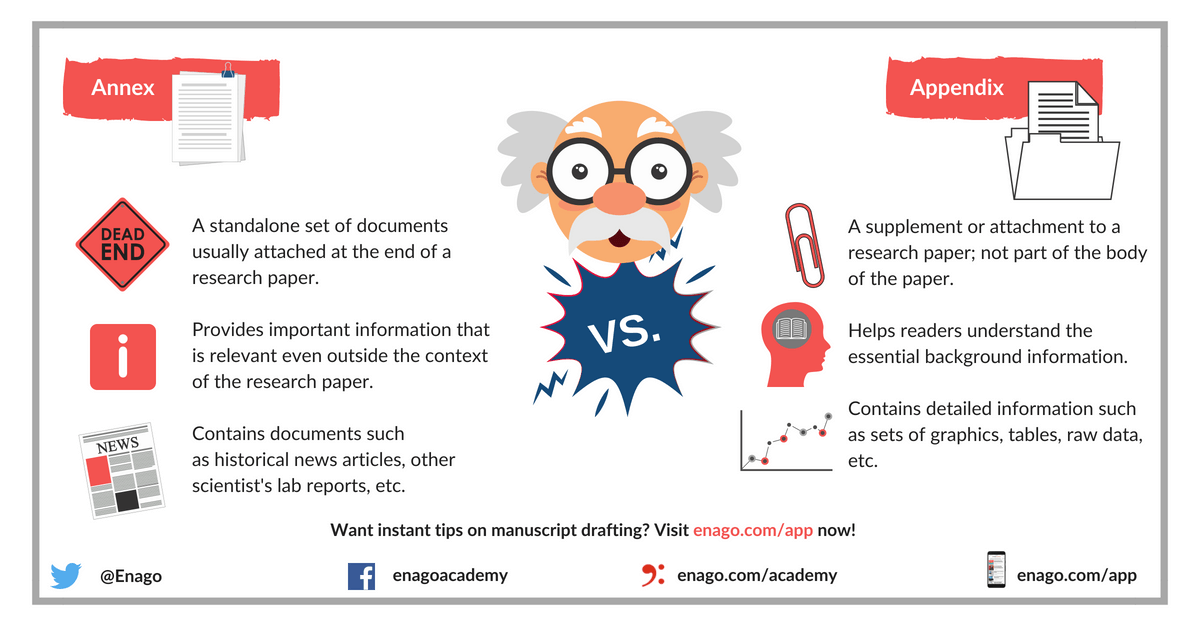Annex Vs. Appendix: Do You Know the Difference?

What do math geniuses, scientific visionaries, economic gurus, legal scholars, leaders in government, business mavens, and the most brilliant minds in academia all have in common? No matter how skilled and informed they are in their fields, they all have to struggle with the technical requirements of the research paper or research report. Almost all the times, they come across the terms “appendix” and “annex”. In particular, researchers and academics at every level and in every field find themselves confused by the annex. What is an annex, why is it important to researchers, and how is it different from an appendix? Let’s have a quick look at the annex in your research paper.
Appendix or Annex in your Research Paper
Many researchers are more familiar with the appendix than with the annex. Like the annex, the appendix is a supplement or attachment to a research paper but is not part of the body of the paper. It contains information that helps readers understand the thesis or it provides essential background on the research process. However, this information is too long or detailed to fit into the main text. Such information could include complex sets of graphics or tables, for example; or it could take the form of long lists of raw data, such as population figures.
An appendix is a kind of annex. In other words, every appendix is an annex, but not every annex is an appendix.
Clearly, the terms are closely related. In practice, however, we can make some general distinctions between the two.
Context and Authorship are the Key Differences
Self-sufficiency
- An annex can stand alone. If you are attaching additional documents to the end of your research paper but they would make complete sense and provide important information even outside the context of your paper, you can categorize them as annexes.
- An appendix tends to be more closely connected than an annex to the main body of the paper. An appendix would not be as informative or valuable outside the context of your paper. While an appendix enhances or expands upon your research paper by adding details like illustrations or case studies, it is never presented to readers by itself.
Related: Do you have questions on manuscript drafting? Get personalized answers on the FREE Q&A Forum!
Authorship
- Generally (but not always), the author of an annex is different from the author of the research paper. For example, you might attach a historical news article, another scientist’s lab report, or an NGO’s collection of demographic data.
- An appendix, on the other hand, is almost always created by the author of the research paper.
You may be wondering whether you really need to understand the distinction between annex and appendix, as long as you’re attaching all the supplementary material that your research paper requires. Indeed you do! Depending on the academic or publishing style guide you’re working with, you may be required to stylize an annex differently from an appendix. Their indexing, page numbering, attachment to a research paper etc., are some of the aspects that may be different for an annex and appendix.

The Finer Points
Now let’s look at some specific examples of appendices and annexes.
Bibliography
- If your bibliography takes the form of a list of general recommended reading related to your thesis but does not provide information on the specific works you cited within the main text, it’s an annex. The topic and scope of the paper determine the content of the bibliographic annex, but not by the specific research you actually wrote about and referenced.
- If your bibliography provides detailed citations for sources you reference in the paper itself, it’s an appendix. The contents of the bibliographic appendix are determined by exactly what you researched and what you wrote in the paper.
Correspondence
- If you attach copies of letters that the subject of your research paper sent to members of her personal circle, that’s an annex. You are not the author of that correspondence and the original exchange of letters had nothing to do with your research paper.
- If you attach emails that you exchanged with collaborators or research subjects, that’s an appendix. You are the author of that correspondence, and the correspondence occurred in the specific context of your researching and writing the paper.
Interviews
- If you attach an interview that a periodical conducted with the subject of your research paper, that’s an annex. You didn’t arrange the interview yourself, and it was originally published outside the context of your own research.
- If you attach the full transcriptions of interviews that you refer to in your research paper and that you yourself conducted, that’s an appendix. You held the interviews as part of your personal research for the paper.
And Next?
Whatever be your field or specialization, if you are doing and appropriately documenting serious research, you must make strong, informed use of the annex and understand how it differs from the appendix. See an example of how annexes are used, and let us know your questions and personal experiences in comments.
Annex is an important aspect of a research paper. For more information on other sections of a research paper, you can check the structure of a research paper. Also make sure your manuscript has covered all the sections and is ready to be submitted to a reputed journal.










Thanks for making it as clear as day.
Concise and offers much-needed clarity.
Great article.
Thank you for the clarification of the two and the clear concept of executing them, much appreciated. I totally enjoyed reading this.